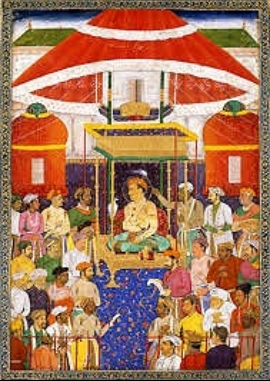Timeline of the Mughal Empire
| Year | Event |
|---|---|
| 1526 | First Battle of Panipat took place, fought between Babur and Ibrahim Lodhi. And Babur defeats Ibrahim Lodhi, Sultan of Delhi. |
| 1527 | Battle of Khanwa took place, Babur conquers the combined army of the Rajput princes ( control over northern India). |
| 1530 | Babur died, and his son Humayan succeded to the throne. |
| 1543 | Pashtun leader Sher Shah Suri defeats Humayan, drives him into exile in Afghanistan. |
| 1555 | Humayun restored the Mughal throne. |
| 1556 | The second battle of Panipat fought between Akbar and Hemu. And Akbar defeated Hemu. Humayan died. |
| 1561 | Akbar conquest of Malwa |
| 1563 | Abolition of Pilgrim Tax |
| 1564 | Abolition of Jizya |
| 1564 | Akbar Conquest of Garhkatanga and Gondwana |
| 1572-73 | Akbar Conquest of Gujarat (built Buland Darwaja at Fatehpur Sikri). |
| 1574-76 | Akbar Conquest of Bihar and Bengal |
| Akbar conquest of Rajput states | |
| 1576 | one by one they were subjugated and submitted to Akbar. |
| Conquest of North-west frontier | |
| 1581 | Akbar conquest of Kabul |
| 1591 | Akbar conquest of Sind. |
| 1595 | Akbar conquest of Qandahar. |
| 1596 | Akbar conquest of Baluchistan and extending his (Akbar) empire to the 'Scientific frontier'. |
| 1605: | Akbar died, and his son Jahangir was succeeded to the throne. |
| 1613 | British East India Company defeats Portuguese at Surat, Gujarat State and establishes the first warehouse in India. |
| 1615 | Britain first ambassador Sir Thomas Roe visited the Mughal court for the first time. |
| 1620 | Jahangir's rule |
| 1627 | Jahangir died, and his son Shah Jahan was succeeded to the throne. |
| 1632: | Hindu temples were destroyed (orders given by Shah Jahan). |
| 1632: | Shah Jahan designs and begins building Taj Mahal (a tomb for his wife Mumtaz Mahal). |
| British East India Company builds Fort St. George in Madras (now Chennai) | |
| 1658: | Aurangzeb imprisons his father (Shah Jahan) in the Red Fort at Agra. |
| 1660-1690: | Aurangzeb expands Mughal rule to more than 3.2 million square km, including Assam, the Deccan plateau, and parts of southern India. |
| 1696: | British East India Company established of Fort William on Ganges delta, fort and trading factory. |
| 1707: | Death of Aurangzeb (end of Mughal Golden Era) his son Bahadur Shah I succeeded to the throne. |
| 1712: | Bahadur Shah I died, his son Jahandar Shah succeeded to the throne. |
Indian History - The Great Mughals
Mughal
Empire was founded by Babur (1526-1530) after the battle of Panipat. Babur
succeeded to the throne of Ferghana in 1494 when he was only 12 years old. In 1526 he defeated the Sultan of Delhi,
Ibrahim Lodi, at Panipat and captured Delhi and Agra.
The
Mughals were descendants of two great race of rulers. such as:
1.Genghis
Khan (died 1227), ruler of the Mongol tribes, China and Central Asia (mother’s
side).
2.
Timur (died 1404), successors of the ruler of Iran, Iraq and modern-day Turkey (father’s
side).
Mughals did not like to be called themselves as Mughal or Mongol. Because Genghis Khan’s associated with the massacre of innumerable people. It was also linked with the Uzbeks, their Mongol competitors.
Mughals were proud of their Timurid ancestry, their great ancestor had captured Delhi in 1398. In the 16th century, they expanded their kingdom from Agra to Delhi. Later on, during the 17th century, they controlled nearly all of the subcontinent. Mughal rulers campaigned constantly against rulers who refused to accept their authority. But as the Mughals became powerful many other rulers also joined them voluntarily. The Rajput’s are a good example. Many of them married their daughters into Mughal families and received high positions.
Rajput’s were honourably treated by the Mughals, given their lands (Watan) back as assignments (Watan jagir). The Mughals were very careful with the balance in between defeating but not humiliating their opponents.
Mansabdars and Jagirdars :
When
their empire expanded to the different regions Mughals recruited various bodies
of people. From a small nucleus of Turkish nobles (Taranis), they expanded to
include Iranians, Indian Muslims, Afghans, Rajput’s, Marathas and other groups.
Those who joined Mughal service were enrolled as Mansabdars.
The
term Mansabdar refers to an individual who holds a Mansab, meaning a position
or rank. It was a grading system used by the Mughals to fix (1) Rank, (2)
Salary and (3) Military responsibilities.
Rank
and the salary was determined by a numerical value called Zat. Higher the Zat,
the more prestigious was the noble’s position in court and the larger his
salary.
The Mansabdar’s military responsibilities required to maintain a specified number
of sawar or cavalrymen. The Mansabdar brought his cavalrymen for review, their
horses branded and received money as salary.
Mansabdars
received their salaries as revenue i.e. called as jagirs (like iqtas). Most Mansabdars did not actually reside in or administer their jagirs. They only had
rights to the revenue of their assignments which was collected by themselves.
Important
Fact:
Babur
(1526-30 CE), Emperor of Hindustan.
- Founder of Mughal Empire.
- At the age of 12, he became the Sultan of Farghana (Afghanistan).
- He established himself first in Kabul (1504).
- He was invited to fight against Ibrahim Lodhi by Daulat Khan Lodhi (Governor of Punjab).
- Babur's soldiers were very strong and superior.
- Method of warfare - Rumi (Ottoman) or Tulguma system of warfare.
Humayun
(c.1530-1556CE)
- Eldest son of Babur. Humayun means fortune.
- His the first confrontation with Sher Khan at Chunar (1532).
- Conquest of Malwa and Gujarat (immediate loss 1535-36)











No comments:
Post a Comment